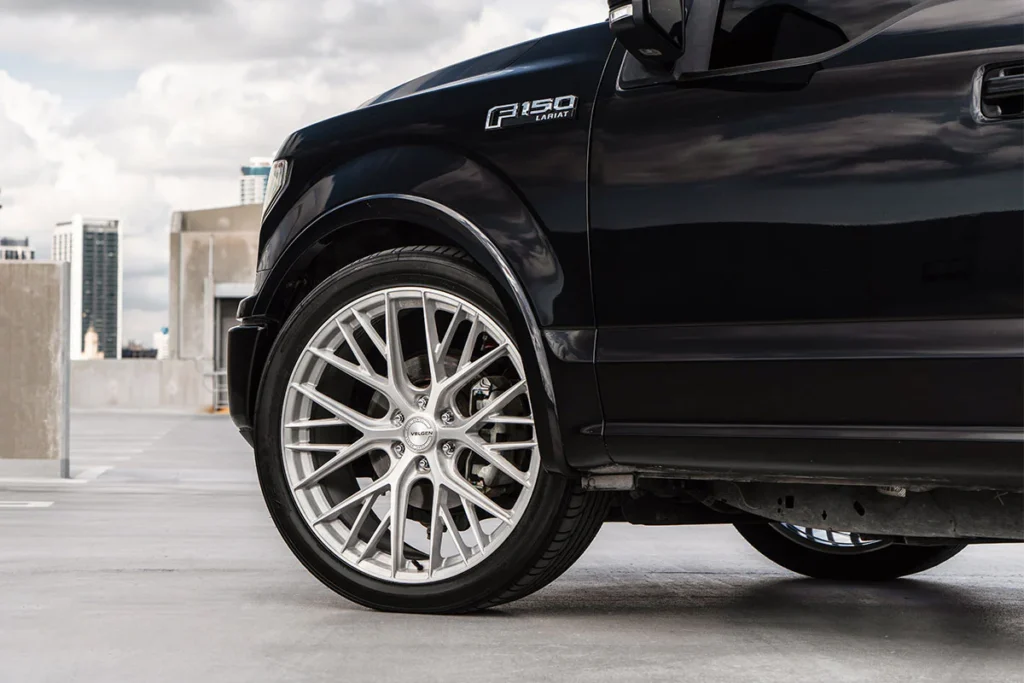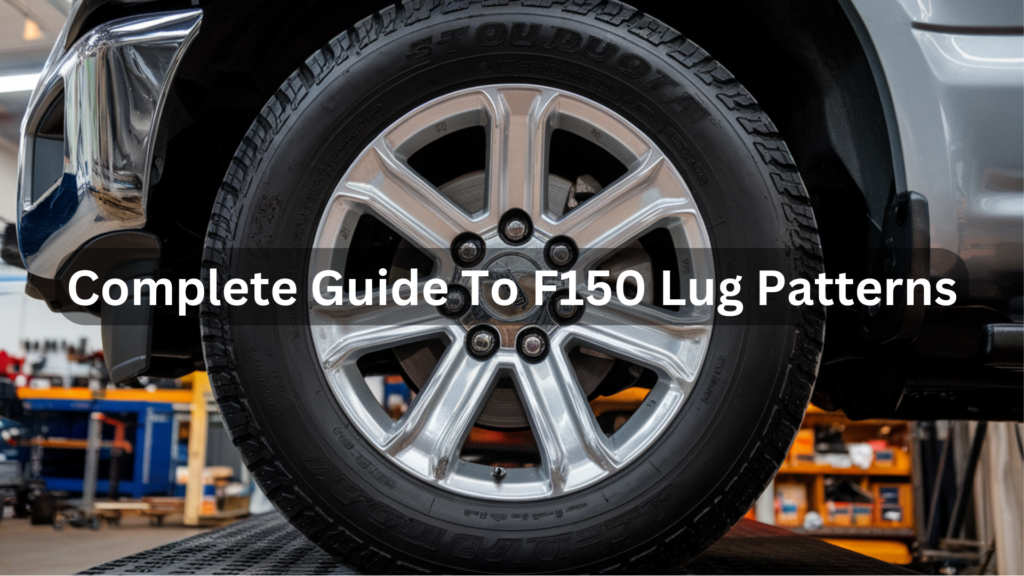Many truck owners struggle with understanding wheel fitment and lug patterns.
I’ve spent years working with Ford trucks and know the frustration of getting the wrong wheels. I’ll walk you through everything you need about F150 lug patterns in this guide.
You’ll learn to identify and measure your truck’s exact pattern correctly and avoid common fitment issues. Whether replacing a damaged wheel or upgrading to a new style, this information will save you time and money.
Trust me when I say that understanding your lug pattern is crucial for your truck’s performance and safety. Let’s get your wheels fitting perfectly!
What is a Lug Pattern?

A lug pattern (also called bolt pattern) is a critical measurement determining which wheels will fit your vehicle. It consists of two important numbers:
- The number of lug nuts or bolts on your wheel
- The diameter of the circle formed by these lugs (measured in millimeters or inches)
Understanding your vehicle’s lug pattern is essential when replacing or upgrading wheels. Using wheels with the wrong lug pattern can lead to poor fitment, unsafe driving conditions, and potential damage to your vehicle.
Lug patterns directly affect wheel compatibility because they determine how the wheel attaches to your vehicle’s hub. When the lug holes on your wheel don’t align properly with the studs on your vehicle, the wheel simply won’t fit correctly.
Some common lug patterns found in vehicles include:
- 4x100mm – Common in many compact cars
- 5×114.3mm – Popular in many sedans and SUVs
- 6x135mm – Used in Ford F150 trucks
- 8x170mm – Found in heavy-duty trucks like the Ford SuperDuty
What Does an F150 Lug Pattern Include?
Overview of the Ford F150 Lug Pattern
The typical lug pattern for Ford F150 trucks is 6x135mm. This means F150s have:
- 6 lug nuts arranged in a circle
- 135mm diameter measured across opposite lug holes
This pattern has been consistent across most modern F150 generations, making wheel selection relatively straightforward. The 6x135mm pattern is also shared with other Ford vehicles, including:
- Ford Expedition (2003-present)
- Lincoln Navigator (2003-present)
- Ford Bronco (2021-present)
This commonality makes it easier to find compatible wheels across the Ford lineup.
Understanding the Numbers in the Lug Pattern
The lug pattern notation (6x135mm) contains two crucial pieces of information:
The first number (6) represents the number of lug nuts or bolts that secure the wheel to the vehicle. The F150 uses 6 lugs arranged in a circular pattern around the hub.
The second number (135mm) indicates the diameter of the circle formed by these lugs, measured in millimeters. This measurement is taken from the center of one lug hole to the center of the opposite lug hole.
Together, these numbers create a specific pattern that must match your wheels and vehicle for proper installation.
The Significance of Bolt Pattern and Offset
The bolt pattern is crucial for wheel installation because it determines the precise positioning of the wheel on the hub. When the pattern matches, the wheel will sit flush against the hub, ensuring:
- Even weight distribution
- Proper alignment
- Secure attachment
Wheel offset and backspacing are equally important considerations when fitting wheels to your F150:
Offset is the distance from the wheel’s mounting surface to the centerline of the wheel. It’s measured in millimeters and can be positive, negative, or zero:
- Positive offset: The mounting surface is toward the front or outside of the wheel
- Negative offset: The mounting surface is toward the back or inside of the wheel
- Zero offset: The mounting surface is even with the centerline
Most F150 trucks use wheels with a positive offset ranging from +30mm to +44mm, depending on the model year and trim.
Backspacing is the measurement from the inside edge of the wheel to the mounting surface. Proper backspacing ensures adequate clearance from suspension components and the wheel well for the wheel and tire assembly.
Wheel and Tire Compatibility
With the standard 6x135mm lug pattern, F150 owners have many wheel options available:
- OEM (Original Equipment Manufacturer) wheels from Ford
- Aftermarket wheels specifically designed for the F150
- Wheels from other Ford vehicles with the same lug pattern
When selecting wheels that fit the F150 lug pattern, also consider:
- Wheel diameter (typically 17-22 inches, depending on the model year)
- Wheel width (usually 7.5-10 inches)
- Proper offset (typically +30mm to +44mm)
For optimal tire fitment with F150 wheels, consider:
- Manufacturer-recommended tire sizes for your specific model
- Load rating adequate for your truck’s weight and hauling needs
- Speed rating appropriate for your driving conditions
- Proper width to match your wheel size
How to Measure the F150 Lug Pattern
Tools You Need to Measure the Lug Pattern
To accurately measure your F150’s lug pattern, you’ll need:
Basic measurement tools:
- Lug nut wrench or socket set
- Measuring tape or ruler (preferably with millimeter markings)
- Jack and Jack stands for safely lifting the vehicle
For more precise measurements:
- Bolt pattern gauge (available at auto parts stores)
- Digital calipers for exact measurements
- Wheel fitment guide specific to Ford vehicles
Having the right tools ensures your measurements will be accurate, preventing costly mistakes when purchasing new wheels.
Step-by-Step Guide to Measuring
To measure the bolt circle diameter:
- Ensure your vehicle is parked on a level surface with the parking brake engaged
- Loosen (but don’t remove) the lug nuts on one wheel
- Safely jack up the vehicle and secure it with jack stands
- Remove the wheel
- For a 6-lug pattern like the F150’s:
- Measure from the center of one lug hole to the center of the hole directly opposite
- If no hole is directly opposite (which is the case with 6-lug patterns), measure from the center of one hole to the furthest point on the opposite hole
- This measurement should be approximately 135mm for most F150 trucks
To count the number of lug holes:
- Simply count the number of lug nuts or studs on your wheel hub
- F150 trucks should have 6 lugs arranged in a circular pattern
Tips for Accurate Measurements
To ensure you’re measuring correctly:
- Always measure from the center of one lug hole to the center of another
- Take multiple measurements and average them for greater accuracy
- Use digital calipers for the most precise results
- Confirm your measurements against Ford’s specifications for your specific model year
Common mistakes to avoid:
- Measuring from the outside edges of lug holes instead of centers
- Assuming all F150 models use the same lug pattern without checking
- Not accounting for wheel spacers or adapters that may be installed
- Relying on visual estimates rather than actual measurements
Common Issues with the F150 Lug Pattern
Misalignment and Poor Fitment
Using wheels with the wrong lug pattern can cause serious problems:
- Inability to properly seat the wheel on the hub
- Uneven contact between the wheel and hub surface
- Excessive stress on lug nuts and studs
- Potential for wheel detachment while driving
To avoid lug misalignment:
- Always verify the exact lug pattern for your specific F150 model
- Use only wheels designed for a 6x135mm pattern
- Ensure proper torque when tightening lug nuts (typically 100-150 ft-lbs for F150s)
- Have wheels professionally mounted if you’re unsure about fitment
Poor wheel alignment due to incorrect lug patterns can lead to:
- Uneven tire wear
- Poor handling and steering response
- Increased fuel consumption
- Premature failure of suspension components
Damaged Threads or Lug Holes
To identify worn or damaged threads on lug studs:
- Look for visible rust, corrosion, or deformation
- Check for stripped or crossed threads
- Inspect for bent or broken studs
- Test for excessive play or movement in the studs
Damaged lug holes in wheels may show:
- Elongated or oval-shaped holes
- Cracks radiating from the holes
- Visible wear marks or shiny spots around the holes
- Improper seating of lug nuts
Replacing damaged components is crucial because:
- Compromised studs or lug holes can fail under stress
- Wheel security depends entirely on these connection points
- Even minor damage can worsen quickly under normal driving conditions
- The cost of replacement is minimal compared to the potential consequences of failure
Wheel Vibrations Due to Incorrect Lug Pattern
Improper wheel fitment often manifests as vibrations that can be felt:
- In the steering wheel (typically at certain speeds)
- Through the floor of the vehicle
- As a shuddering sensation during acceleration or braking
These vibrations occur because:
- The wheel isn’t centered properly on the hub
- Weight distribution of the wheel/tire assembly is uneven
- The wheel may be wobbling slightly on the hub
To correct issues related to lug pattern misalignment:
- Verify your F150’s exact lug pattern
- Remove any wheels with incorrect patterns
- Install properly matched wheels
- Ensure lug nuts are torqued to specification in the correct sequence
- Have the wheels professionally balanced
- Consider a wheel alignment if vibrations persist
Upgrading or Changing Your F150 Wheels
Why You Might Want to Change Your Wheels
There are several reasons F150 owners choose to upgrade their wheels:
Performance benefits:
- Reduced unsprung weight with lighter wheels
- Improved handling with wider wheels
- Better off-road capability with wheels designed for rugged terrain
- Enhanced brake cooling with open-spoke designs
Style considerations:
- Customizing your truck’s appearance
- Modernizing older F150 models
- Color matching or contrasting with the vehicle’s paint
- Increasing wheel diameter for a more aggressive stance
The lug pattern plays a crucial role in wheel upgrades because:
- It’s the primary fitment constraint when selecting new wheels
- Adapters can sometimes be used but may affect handling and safety
- Proper lug pattern matching ensures the optimal performance of your new wheels
Aftermarket Wheels for F150
The market offers numerous aftermarket wheel options for F150 trucks:
Popular styles include:
- Cast aluminum alloy wheels (affordable, wide variety of designs)
- Forged wheels (stronger, lighter, more expensive)
- Beadlock or simulated beadlock wheels (for serious off-road use)
- Chrome, machined finish, or powder-coated options in various colors
When choosing new wheels, consider:
- Your driving conditions (highway, city, off-road)
- Weight rating appropriate for your truck’s use
- Clearance requirements for suspension and brake components
- Finish durability in your climate
- Budget constraints
- Warranty and support from the manufacturer
Ensuring Proper Wheel Fitment
Confirming the correct lug pattern and bolt offset is essential:
- Always verify the new wheels are designed for a 6x135mm bolt pattern
- Check that the center bore of the wheel matches your F150’s hub diameter (typically 87.1mm)
- Ensure the offset is appropriate (usually +30mm to +44mm, depending on model year)
- Verify the wheels havean adequate load rating for your truck
Professional installation is recommended because:
- Proper torque sequence and specifications are critical
- Special tools may be required for installation
- Professionals can check for any clearance issues
- Many installers offer warranties on their work
- Wheel balancing needs to be precise for smooth operation
Conclusion: Understanding Your F150 Lug Pattern
Understanding your Ford F150’s lug pattern is essential for maintaining your truck’s performance and safety. The standard 6x135mm pattern used in most F150 models determines which wheels will properly fit your vehicle.
We’ve covered the importance of:
- Correctly identifying your specific lug pattern
- Properly measuring the bolt circle diameter
- Understanding how offset and backspacing affect wheel fitment
- Recognizing and addressing common issues related to lug patterns
- Selecting appropriate wheels when upgrading
Remember that using wheels with the incorrect lug pattern can lead to serious safety hazards, including poor handling, excessive vibration, and even wheel detachment.
Whether you’re replacing a damaged wheel or upgrading for performance and style, always verify the lug pattern compatibility before purchasing new wheels. When in doubt, consult with a professional wheel installer or your Ford dealer to ensure proper fitment.
By taking the time to understand your F150’s lug pattern, you’ll save money, avoid frustration, and ensure your truck continues to perform safely on and off the road.
Frequently Asked Questions
What is the lug pattern for a 2020 Ford F150?
The 2020 Ford F150 typically has a 6x135mm lug pattern. However, check the model year and trim for any variations.
Can I use different lug patterns on my F150?
No, using the correct lug pattern for your F150 is essential. Using an incompatible lug pattern can lead to safety risks, including improper wheel fitment.
How can I confirm my F150’s lug pattern?
You can confirm your F150’s lug pattern by measuring the distance between two opposite lug holes or checking the vehicle’s manual for specifications.
What happens if the lug pattern is incorrect?
An incorrect lug pattern can cause the wheels not to fit properly, leading to wheel misalignment, vibration, or even wheel detachment while driving.
Can I use aftermarket wheels with the F150 lug pattern?
Yes, many aftermarket wheels are designed to fit the F150’s 6x135mm lug pattern. However, for optimal performance, make sure to check for the correct offset and backspacing.


